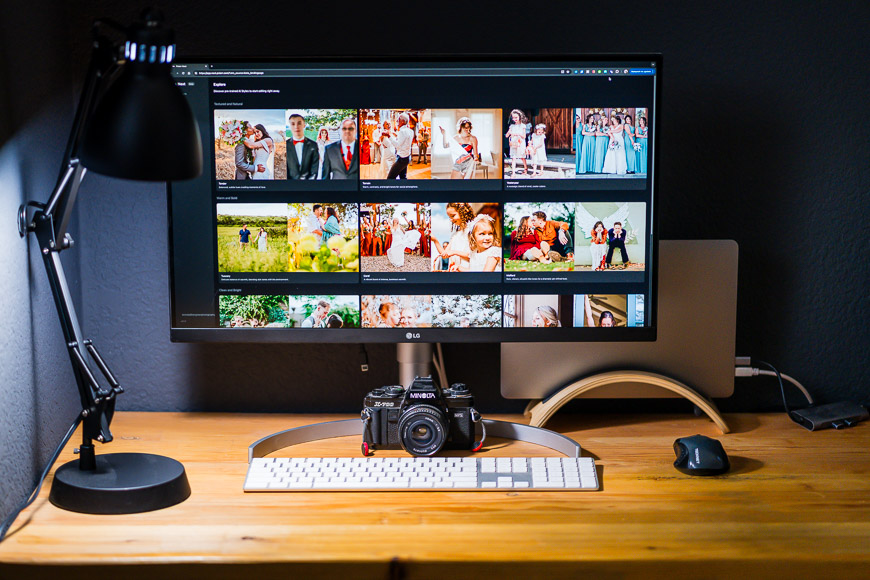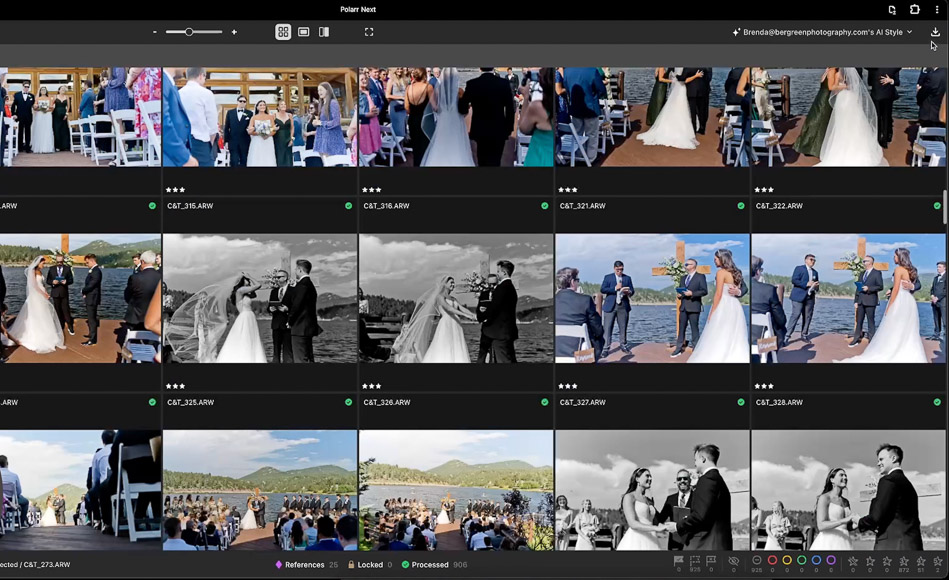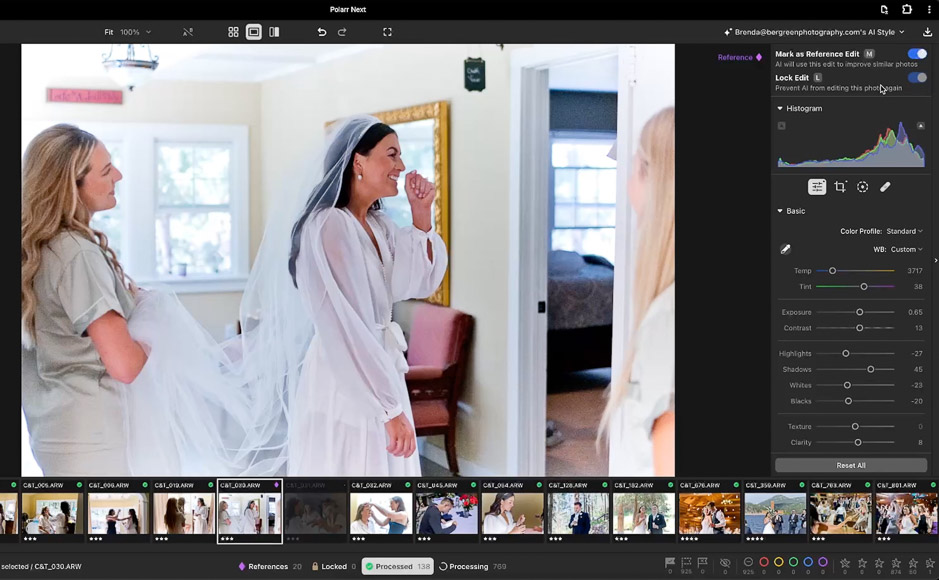[adinserter block=”1″]
This Polarr Next Review is a comprehensive look at a new, innovative, AI-powered editing software for photographers.
With so many photographers turning to AI to help with the burden of photo editing, it’s exciting to see new software tools rising to the occasion.
Polarr Next is a great option for wedding or portrait photographers looking to save time and add more consistency to their editing by utilizing AI.
Highly Recommended
Intuitive photo editing app that uses powerful AI to learn your editing style in real time, saving you hours of time and effort.
It’s super easy to get started with Polarr Next. Minimal setup is required, and training your AI tools is done on the fly with an interface very similar to Adobe Lightroom.
Finally, Polarr Next is positioning itself as a standalone app that could eventually eliminate the need for your other photo retouching and editing software.
This unique approach is innovative and potentially saves you from the burden of paying for Adobe subscriptions.
Read on to see how this new software could save you a significant amount of time editing photos!
What is Polarr Next?
- Super fast setup
- AI adapts in real time
- Powerful interface
- Easy to learn
- Highly customizable
- Fast import, edit, and export
- Potential to be a standalone tool
- Still in beta
- Requires you to teach it your style
Built specifically for wedding and portrait photographers but applicable to many other types of photography, Polarr Next is an innovative option for AI photo editing.
Polarr Next is a web-based app that mimics your editing in real time by applying those edits across multiple photos from similar lighting conditions.
As you edit reference images, Polarr Next applies similar edits to photos with similar lighting conditions, expediting your workflow.
Instead of manually syncing editing settings across similar images and customizing for every slight change in lighting, Polarr Next is doing this for you. While you watch.
Fast!
Each time you tweak a section of your edits with a reference photo, it automatically updates the nearby images with similar lighting conditions.
This highly customizable approach to AI photo editing is very impressive.
Features of Polarr Next
One of the cool things about Polarr Next is that it takes a different approach to editing than some of its competitors.
Rather than requiring that you upload thousands of previously edited images, Polarr Next uses reference edits.
Essentially, reference edits are edits that you make on select photos from various lighting conditions that Polarr Next then uses to edit the rest of your images.
Initially, Polarr Next selects up to 20 images from your project for you to edit. You then edit those images to your liking.
Once you’ve edited the images, you mark them as reference edits, and Polarr Next knows to learn from how you edited them given the specific lighting conditions.
From there, Polarr Next edits the rest of your project based on your editing style.
You can make corrections in real time by selecting images that seem off, re-editing them, and marking them as reference edits.
Polarr Next will then make live updates to any images with similar lighting conditions.
You can continue to make reference edits until you’re satisfied with the entire gallery, and then you can use this newly created editing style on future projects.
Reference edits are a unique and innovative way to help photographers start using AI editing.
It’s a system that will likely be perfect for newer photographers or photographers who are interested in changing their editing style from what they’ve been doing.
-
Real-Time Editing Updates
My favorite Polarr Next feature is the instant feedback that comes from the real-time editing updates.
Once you mark an image as a reference edit, Polarr Next starts to update similar images in real time.
This is cool because you can instantly see the changes being made and therefore tweak as necessary.
The immediate feedback is really nice because you can see which images Polarr Next is considering similar.
If you deem that one of the images should be edited differently than the associated reference edit, you can lock it to be edited separately.
Polarr Next is extremely fast at editing, even with real-time editing updates.
You can immediately start tweaking edits as it continues to process your images, and the total processing time is incredibly efficient.
Another impressive feature of Polarr Next is the in-app tools in the photo editor.
Essentially, you can edit your images right in Polarr Next using in app editing tools that feel like you’re working inside of Lightroom.
If you’re familiar with using Lightroom, using Polarr Next’s editing tools will be incredibly intuitive with a minimal learning curve.
When I tested the editing, I found that the only thing I had to spend time figuring out was how to adjust the angle of the graduated filter tool.
Instead of spinning from the middle, I just had to spin from the top or bottom.
Everything else was intuitive and I didn’t have to do any research to learn how to use it.
Lastly, because of the in-app editing tools, Polarr Next is positioning itself as a standalone application.
You can simply import photos, edit them, and then export them for your client.
In theory, you could eliminate the need for other editing tools.
While some photographers will be greatly resistant to this, others will be excited about the simplicity as well as the competition for Lightroom.
If Polarr Next intends to replace our need for Lightroom and its alternatives, I expect we’ll see some more features in future updates that will help reduce resistance.
For example, will Polarr Next come up with a cool way to organize our folders and create collections?
Will Polarr tackle culling next?
Overall Performance
Overall, Polarr Next is a very impressive AI editing software. It seemed to work very quickly on my M1 Macbook Pro that’s a few years old.
However, it’s worth noting that Polarr Next runs as a web application. You can download Polarr Next as a PWA (Progressive Web App) and have an icon on your computer that makes it seem like software on your computer.
From importing to exporting to processing edits in real time, I’m pretty impressed that the Polarr photo editor was able to do so much so quickly.
As I already mentioned, the editing tools worked great, and despite being in beta, I found minimal glitches with the software.
How I Tested Polarr Next
For this Polarr review, the way I tested the software was relatively simple. I was able to process a full wedding in a couple of hours.
Essentially, I chose a wedding gallery with a large number of images from a wide variety of lighting conditions.
After importing my images, Polarr Next first chose 19 reference edits for me to make.
Then, Polarr Next used those reference edits to start processing my images.
From there I was immediately able to start making tweaks to images that didn’t look right and watch it live update similar images.
I could continue to make tweaks and either mark them as reference edits or lock the edit as a standalone edit until I was satisfied with the entire gallery.
From there, I could batch export .jpgs to deliver to the client.
Polarr next then creates a .catalog file, .style, and the .xmp files for the raw files.
You still have your untouched raw files, and you can use the .xmp files to edit your photos in Lightroom if you want to.
Alternatives to Polarr Next
Polarr Next is poising itself to compete with Imagen AI and Aftershoot Edits. While both Imagen AI and Aftershoot are more established and also offer culling, Polarr Next doesn’t seem to be trying to be the same thing.
Instead, it feels like Polarr Next is trying to address one of the main problems with the other programs.
Both Imagen AI and Aftershoot require you to upload a Lightroom catalog of 2500+ edited images in order for them to build your style or profile that they will then use to make edits.
The more edited images that you upload, the better your chances of having these tools edit photographs the way that you would.
Now, this works great for photographers with an established editing style across various lighting conditions.
But what about the photographer that doesn’t have a large catalog or edited images?
Polarr Next is proactively learning from the photographer’s editing style as they edit a photoshoot or event.
This is a really cool concept.
Now, for photographers who already have an established editing style, this process might feel a little tedious, and uploading a large catalog of previously edited images might actually be faster. It really depends on what’s best for you.
Value for Money
Polarr Next charges around 0.05 cents per exported photo, which seems fairly competitive in the market.
If you export 500 images at 0.05 cents per image on one wedding, that would cost you $25 in editing images, which might be 4x faster than editing without Polarr Next.
If you save 5 hours of editing time, you’ll spend $5 per hour of saved time. That’s less than what you would have to pay a photo editor to outsource your editing.
Therefore, if you can use that time to go make more than $5, then it’s probably worth it.
You’ll want to run your own numbers on how much time you think it will save you and the resulting cost of those hours.
The unlimited pricing model is high at around $130 per month, though they are offering a Founders Unlimited deal for the first 500 users for $50 per month, which feels more competitive.
I was asking myself why they thought to value the unlimited pricing so high. At first I thought it was an inflated price so that the Founders deal would feel like a discount.
But then I realized that you could technically use Polarr Next without needing Lightroom, which would eliminate the costs of other editing tools.
However, the monthly price still looks high as compared to Imagen AI or Aftershoot.
But that doesn’t mean it’s not worth it. If you have a high-volume business, paying money to save time so that you can book more work is one way to make your business scalable.
It’s likely still cheaper than hiring a full-time photo editor.
Still, you have to shoot a lot to make the annual price pencil out, so the best bet if you’re interested in Polarr Next is to get in at the Founders Unlimited price.
Polarr Review FAQ’s
Who is Polarr Next best suited for?
I would say Polarr Next is best suited to photographers looking to use AI for editing large quantities of images who don’t want to spend a bunch of time getting set up. It’s a web based software that functions very quickly with almost no time required for setup.
How much does Polarr Next Cost?
At just $50 per month for unlimited edits on their introductory offer, Polar Next is an affordable option for people with a lot of edits to make. It’s also unique because it doesn’t require other subscriptions like Adobe Lightroom to export your images from RAW to JPG.
How can I get started with Polar Next?
Polarr Next is extremely easy to use. Simply load the web app and upload a folder of images. You don’t have to pay anything to try it; only pay once you’re ready to export and deliver your images!
Polarr Next Review | Conclusion
In summary, Polarr Next is an impressive AI editing option that utilizes some very creative concepts.
I love the reference edits concept and the real-time edits – these are innovative ways to solve our editing needs.
The in-app editing tools are also really impressive, as you feel like you’re editing inside of Lightroom.
Learning to use Polarr Next was very easy and intuitive. The web-based app is also extremely quick and responsive, from importing to live editing and exporting.
However, for someone like me, it’s still likely to take less of my time to train Imagen AI or Aftershoot to edit in my style.
I already have a large catalog of previously edited images across a wide range of lighting conditions, which makes using Imagen or Aftershoot very efficient and effective.
Sure, I have to wait longer for my images to be edited, but I can go grab a coffee while I’m doing that. I don’t personally need to fine-tune the edits live.
I’m not going to be switching to Polarr Next at this time, but I think it’s a great option for someone who doesn’t have a large catalog of previously consistently edited images.
Whether you’re just building your editing style or refining it, Polarr Next can proactively learn from you as you edit, eventually saving you significant editing time.
I’ll also be watching as Polarr Next provides an innovative alternative to Lightroom as a standalone AI editing app!
Highly Recommended

Intuitive photo editing app that uses powerful AI to learn your editing style in real time, saving you hours of time and effort.
[adinserter block=”1″]
Credit : Source Post








